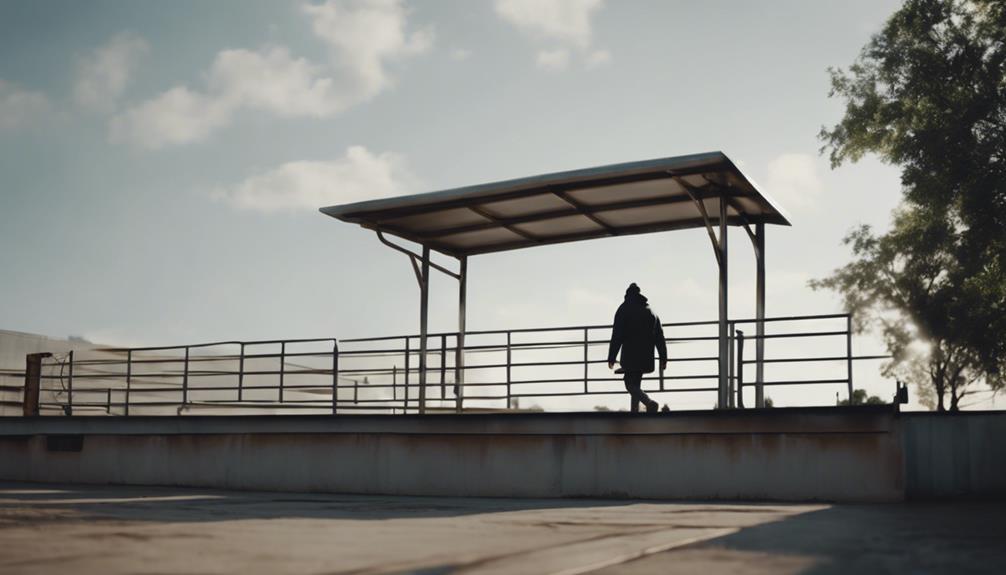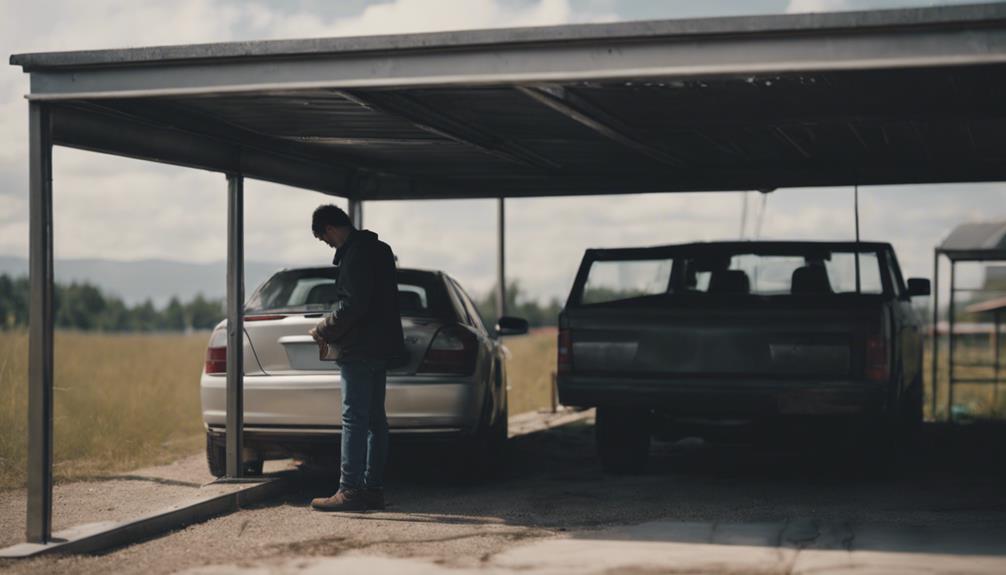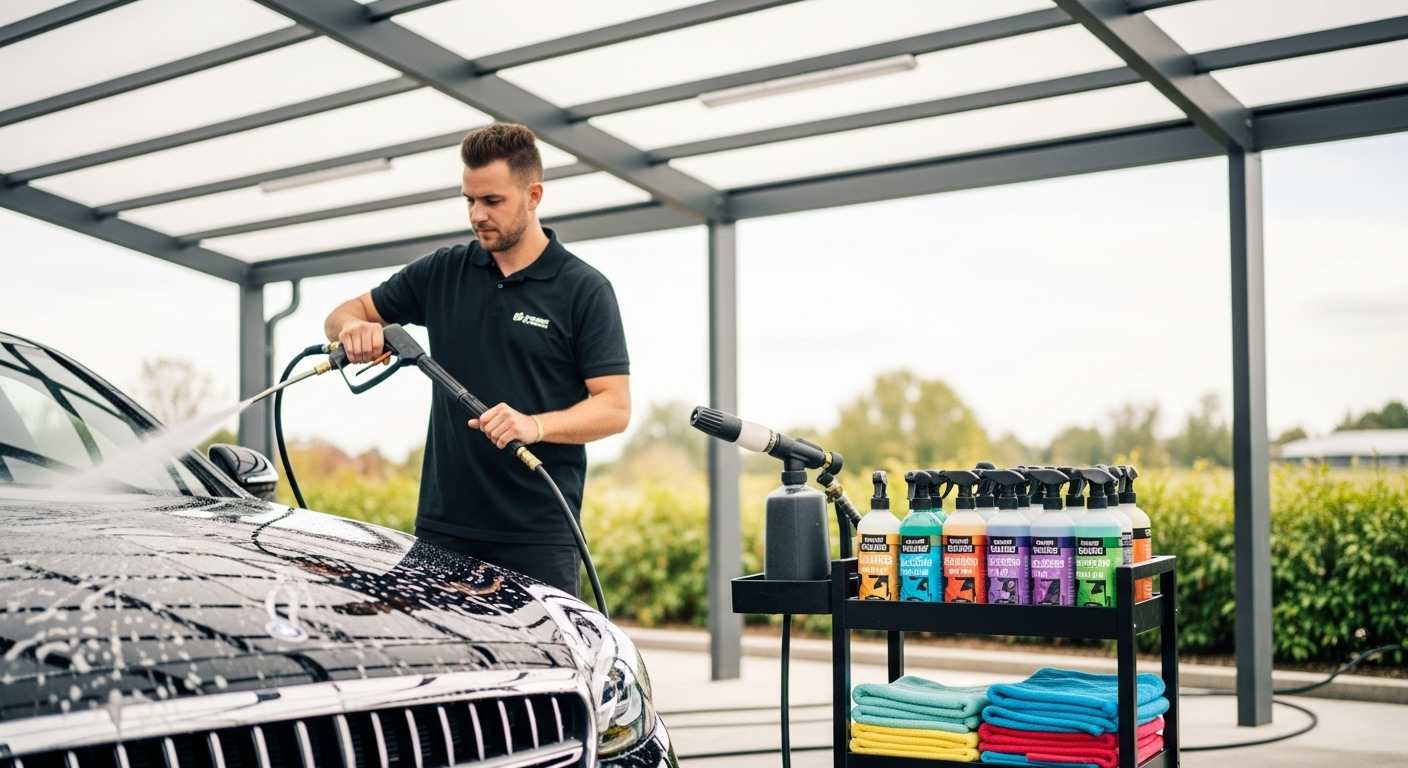I’ve been curious if I can safely walk on my metal carport, similar to how I walk on the ground. Using that extra space is tempting, but safety comes first.
Before walking on it, it’s critical to consider a few key points to ensure your safety and the carports.
Let’s dive into whether walking on a metal carport is safe and what steps we should take to do so without any risks.
Key Takeaways
- Metal carport roofs are not designed for foot traffic due to safety risks and potential damage.
- Prioritize safety with proper footwear and use a safety harness if accessing the roof.
- Consult weight capacity limits specified by the manufacturer or an engineer before walking on the roof.
- Explore alternatives like hiring a professional roofer or using extension tools for safe access.
Understanding Metal Carport Structures

Understanding how metal carport structures work is key for homeowners who want to ensure their outdoor shelter is safe and fully functional. It’s crucial to regularly check the roof for any damage or signs of wear that could weaken the carport.
It’s especially important to be careful about climbing the roof since metal roofs aren’t meant for walking on. Being safe means not taking unnecessary risks and asking for professional help.
Knowing how much weight your metal carport roof can handle is also essential. Putting too much weight on it could cause serious damage, so it’s a good idea to look at the manufacturer’s manual or ask an expert for advice.
If you need to get on the roof for any reason, it might be safer to hire a professional roofer instead. This way, you avoid danger and keep your carport in good shape.
Evaluating Carport Material Strength

When looking into how strong the material of a metal carport is, it’s really important to consider how much weight it can hold. This ensures the carport stays sturdy and safe. Especially when it comes to the roof, you shouldn’t just walk on it without knowing if it can support your weight.
Metal carports are built to handle weather like rain, snow, and wind, but putting too much weight on them can cause serious damage. It’s vital to check the carport’s manual for how much weight it can safely support. If you can’t find this information, asking an expert, like an engineer, for advice is a good idea.
Making sure you stay safe is key. Instead of climbing onto the roof yourself, you might want to consider getting a professional roofer or using tools to reach the roof from the ground. This way, your metal carport will last longer and remain functional while avoiding unnecessary risks.
Potential Risks of Walking on Carports

Walking on metal carports can pose significant risks that shouldn’t be overlooked. Slip and fall hazards are a primary concern, especially in wet or icy conditions.
Structural damage risks and weight limit concerns further emphasize the importance of cautious behavior when walking on a metal carport roof.
Slip and Fall Hazards
Walking across metal carport roofs requires careful consideration of slip and fall risks. Here’s a straightforward look at these hazards:
- Roof Safety: Walking on metal roofs is risky because they’re not built for people to walk on. This makes it easier to slip and fall.
- Footwear: Wearing shoes with a strong grip can help you avoid slipping.
- Safety Gear: If you will be up high for a while, it’s important to wear a safety harness and lifeline.
- Weight Limits: Putting too much weight on the roof of a metal carport can damage it.
Focusing on safety and knowing the roof’s weight capacity is crucial. Sometimes, it’s better to call in professionals to avoid accidents and keep your carport in good shape.
Let’s break this down further:
Walking on a metal carport roof comes with its challenges. Firstly, these roofs aren’t made for foot traffic, which significantly increases the chance of taking a tumble. Understanding this can guide us to take precautions, like wearing the right shoes. Shoes with strong traction can make a big difference in preventing slips.
Moreover, for those who need to be on the roof for extended periods, equipping oneself with safety gear such as a harness and lifeline isn’t just a good idea—it’s a necessity. This step is about acknowledging the heights and the risks involved and then acting to mitigate those risks.
Another point to consider is the roof’s weight capacity. Overloading a metal carport roof isn’t just a slip hazard—it can compromise the structure. Being mindful of this limit is part of ensuring the longevity and safety of the structure.
Navigating the risks of walking on a metal carport roof is more than just avoiding a fall. It’s about understanding the inherent risks, taking preventive measures, and recognizing when to seek professional help. By considering these considerations, we can ensure our safety and the structural integrity of the carport.
Structural Damage Risks
When figuring out if walking on carport roofs is safe, it’s really important to know how much weight they can hold. This is because if the roof can’t support the weight, it might get damaged. Ensuring the roof is strong enough to walk on is key to keeping it in good shape.
If too much weight is put on the roof, it could lead to serious problems. That’s why knowing the weight limit of your carport is crucial to prevent any damage.
When you need to be on the roof, for example, to do some maintenance, wearing the right shoes and maybe even using a safety harness can help keep you safe. Sometimes, it’s a better idea to hire a professional roofer to do the job.
They know how to take care of the roof without causing any harm, ensuring that your carport stays in top condition and everyone stays safe.
Weight Limit Concerns
When considering the safety of getting on top of carport roofs, it’s important to know how much weight they can handle to avoid damaging them.
- Understanding Weight Limits: Carports made of metal have a maximum weight they can support. If this limit is exceeded, it could cause harm to the roof. It’s like knowing the maximum number of people a small boat can safely carry without risking it to sink. Just as you wouldn’t overload the boat, you shouldn’t overload the carport.
- Taking Safety Seriously: If you need to get on the roof, wear the right shoes and use safety gear such as harnesses. Think of it as preparing for a hike. You wouldn’t wear flip-flops and go without water. Similarly, preparing for roof safety means gearing up properly.
- Keeping the Roof in Good Shape: Stepping on metal carport roofs might weaken them if they’re too heavy. It’s akin to walking on thin ice; it will crack if it’s too much for the ice to bear. Ensuring you stay within weight limits helps keep the roof strong and intact.
- Seeking Expert Advice: It’s wise to ask a professional engineer or a roofing expert for advice on how much weight your carport can safely support and how to access it without risk. This is similar to consulting a map and local guides before exploring a new trail. They can offer insights and recommendations to ensure a safe and enjoyable experience.
Precautions Before Stepping on a Carport

Before you go onto a carport roof, thinking about safety and the risks of being up there is crucial. Wear shoes that won’t slip, like those with soft soles and a good grip. If you’ll be up there for a while or if it’s quite high, wear a safety harness and attach a lifeline to something strong.
It’s important to know how much weight the carport can hold. Check the manual with it or talk to an engineer to get this info. Sometimes, it’s better to let professional roofers do the work to avoid damaging the roof.
If you need to reach something high, use tools that extend or set up scaffolding instead of risking the carport’s structure.
Alternatives to Walking on a Carport

When working on a carport’s upper areas, avoiding walking directly on the roof is crucial. This practice can damage the structure and pose safety risks.
Instead, tools like ladders or scaffolding offer a safer way to reach these spots. They provide stable support, ensuring you don’t compromise the carport’s integrity or safety.
- Choose Safety First: It’s important to avoid any harm to yourself or the carport. Walking on the roof isn’t worth the risk. Instead, looking into safer options like ladders or scaffolding can make a big difference.
- Safe Highs with the Right Tools: Ladders and scaffolding aren’t just tools; they’re your safety net. They allow you to safely access high areas without taking unnecessary risks. This approach protects both you and the carport from potential damage.
- Seek Expert Advice: Sometimes, the best action is to call experts. If you’re unsure how to safely work on your carport, asking a professional engineer or hiring a skilled roofer can save you from making costly mistakes. These experts have the knowledge and experience to handle the task properly.
- Invest in Quality Tools: High-quality extension tools are worth the investment. They provide safe access to difficult-to-reach areas and ensure stability and reliability when you’re working off the ground.
Conclusion
Walking on a metal carport roof requires a careful approach to ensure safety. A significant number of accidents, around 70% that involve falling from heights, happen because people don’t take the right safety measures. This statistic highlights the importance of being cautious and prepared.
Before stepping onto a metal carport, it’s crucial to consider the strength of the materials. Not all metal roofs are designed to support the weight of a person. Ensuring the carport is sturdy enough and using proper safety gear can help prevent accidents.
It’s all about keeping safe while maintaining the condition of the carport. By taking steps like checking the roof’s condition, wearing the right safety equipment, and perhaps consulting with a professional, you can avoid potential dangers.
Safety should always be the top priority when dealing with outdoor structures, not just for personal well-being but also to ensure that the structure remains undamaged.
For more detailed information on safety measures and best practices when working on or around outdoor structures like metal carports, the Consumer Product Safety Commission (CPSC) offers guidelines and recommendations. Visit their website for insights: [CPSC Safety Tips].
Remember, taking a moment to prepare and understand the task can significantly prevent accidents and ensure that your metal carport lasts a long time.
Frequently Asked Questions
Are Any Specific Weight Limits for Metal Carports Based on the Material Used in Construction?
Weight limits for metal carports vary based on material strength and construction. Understanding load capacity is essential for maintaining structural integrity. Safety precautions, including consulting manuals or engineers, guarantee the carport’s longevity. Prioritize safety to avoid damage.
What Are the Common Signs That Indicate a Metal Carport Roof May Be Unsafe to Walk On?
Safety precautions, structural integrity, and roof maintenance are essential. Signs of an unsafe metal carport roof include visible dents, sagging areas, rust, loose screws, or holes. Regular inspections, adherence to weight capacity, and prompt repairs are key.
Can Extreme Weather Conditions, Such as Heavy Snow or Strong Winds, Affect the Safety of Walking on a Metal Carport Roof?
Extreme weather conditions can greatly impact roof safety on a metal carport. Heavy snow loads and strong winds can exceed weight limits, compromising the structure. Walking risks increase during such conditions, emphasizing the importance of caution.
Are There Any Specific Maintenance Tips to Ensure the Longevity and Durability of a Metal Carport Structure?
Ensuring a metal carport’s longevity involves rust prevention, regular cleaning, paint maintenance, structural inspection, and weatherproofing techniques. Consistent upkeep preserves structural integrity and aesthetic appeal, safeguarding against environmental wear and tear.
How Can One Determine if a Metal Carport Roof Requires Repairs or Replacement Without Walking on It?
When determining if a metal carport roof needs repairs or replacement without walking on it, conduct a thorough roof inspection from the ground. Implement safety measures, seek professional assessment, and adhere to a maintenance schedule to maintain structural integrity.







Leave a Reply